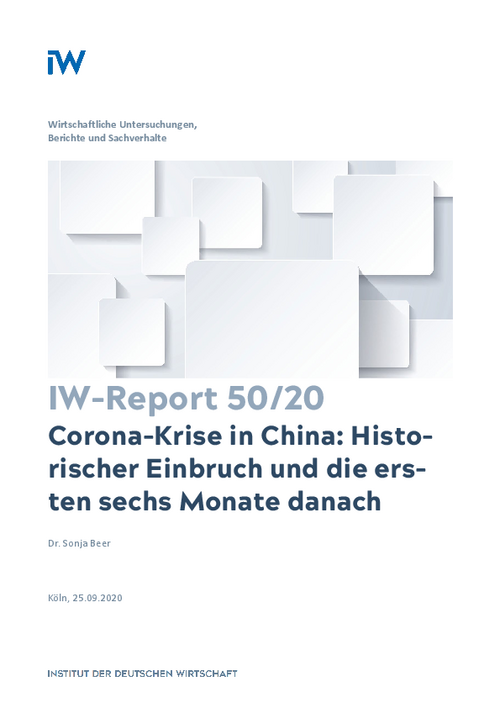The first corona cases in China appeared in December 2019. To contain the pandemic, the government had to take far-reaching measures in February. Although these measures reduced the numbers of new cases, they also had a dramatic impact on the economy.

Corona Crisis in China: Historic Slump and the First Six Months Thereafter
IW-Report

The first corona cases in China appeared in December 2019. To contain the pandemic, the government had to take far-reaching measures in February. Although these measures reduced the numbers of new cases, they also had a dramatic impact on the economy.
Although China was the first country to be hit by the pandemic and the resulting economic crisis, China is also the first country on the path to recovery. After the historic drop in economic performance of 6.8 percent in the first quarter of 2020, the Chinese economy grew by 3.2 percent in the second quarter. Hardly any other country is likely to achieve such a high growth rate. Analysis of the individual GDP components suggests that investment was the main driver of growth in the second quarter. The infrastructure investments and construction activity resulted primarily from the government's measures to support the economy. Industrial production is showing signs of a strong recovery. Since March, the purchasing manager index for industry and the service sector has continuously achieved more than 50 points, which is considered to be an expansion threshold. In July and August, the Shanghai Stock Exchange Index even reached values around the 3500 points in some cases (the highest values within the last two years), which shows the greater confidence in the financial markets. However, there are still several economic challenges in China, such as restrained consumption and weak employment.
After the sharp fall in trade in January and February, China is currently experiencing a foreign trade boom. This applies above all to the development of exports. China's total exports fell 17.2 percent in January and February. In August they recorded an increase of 9.5 percent compared to the same period of the previous year, which was the highest increase in a year and a half. China's foreign trade with Germany and the United States was also severely impacted by the pandemic. After exports fell by 24.1 and 27.7 percent respectively in January and February compared to the same period of the previous year, Chinese exports have been increasing steadily again since March. In May and July, China's exports to Germany even surpassed the $ 8 billion mark, which is the highest monthly value in 2019 and 2020. This means that in the months of January through August, Chinese exports to Germany increased by 3.9 percent compared to the previous year, which signals a strong recovery. Exports to the US show a similar trend. In August, China exported nearly $ 45 billion in goods to the United States, the highest value since November 2018. There is great hope that the strong export growth could boost China's economic growth in the coming months. However, there is also the risk that the strong foreign demand will not be sustainable, as it is mainly based on sales of protective Covid-19 equipment and household items.
China's imports have developed less positively in the last few months and are still in negative territory compared to the same period last year. In July and August, China posted a year-on-year decline in imports of 1.4 and 2.1 percent, respectively. The same applies to imports from the US and Germany. This indicates weak domestic demand. In addition, China did not import more machines but mainly more raw materials and agricultural products. China's trade surplus with the US reached USD 34.2 billion in August, even higher than in June 2018 before the start of the trade war (USD 29 billion). At the same time, China’s trade with ASEAN countries increased in 2020, and ASEAN overtook the EU as China's main trading partner.

Sonja Beer: Corona-Krise in China – Historischer Einbruch und die ersten sechs Monate danach
IW-Report

More on the topic
Not so Different?: Dependency of the German and Italian Industry on China Intermediate Inputs
On average the German and Italian industry display a very similar intermediate input dependence on China, whether accounting for domestic inputs or not.
IW
China’s Trade Surplus – Implications for the World and for Europe
China’s merchandise trade surplus has reached an all-time high and is likely to rise further. A key driver appears to be a policy push to further bolster Chinese domestic manufacturing production, implying the danger of significant overcapacities.
IW